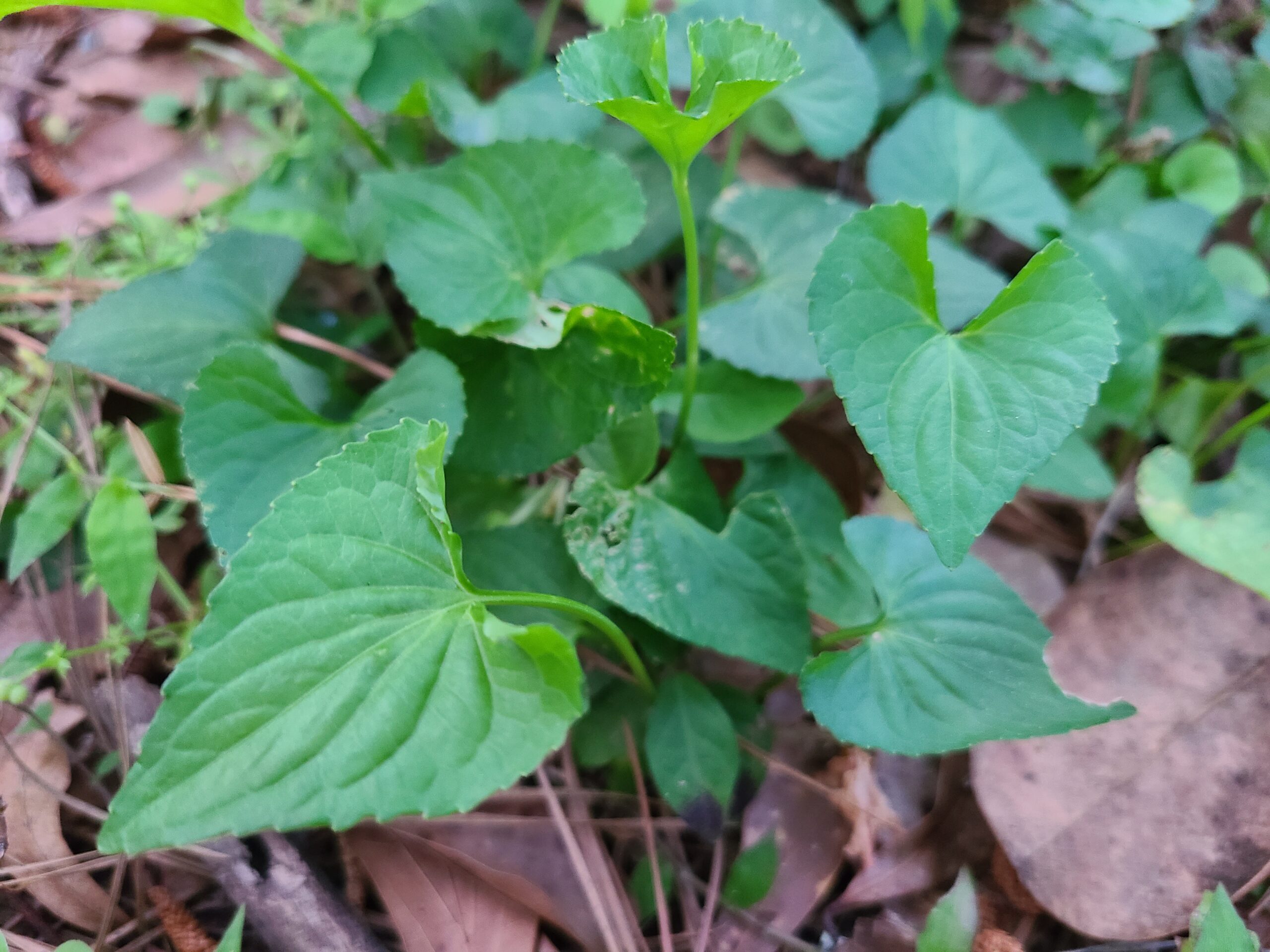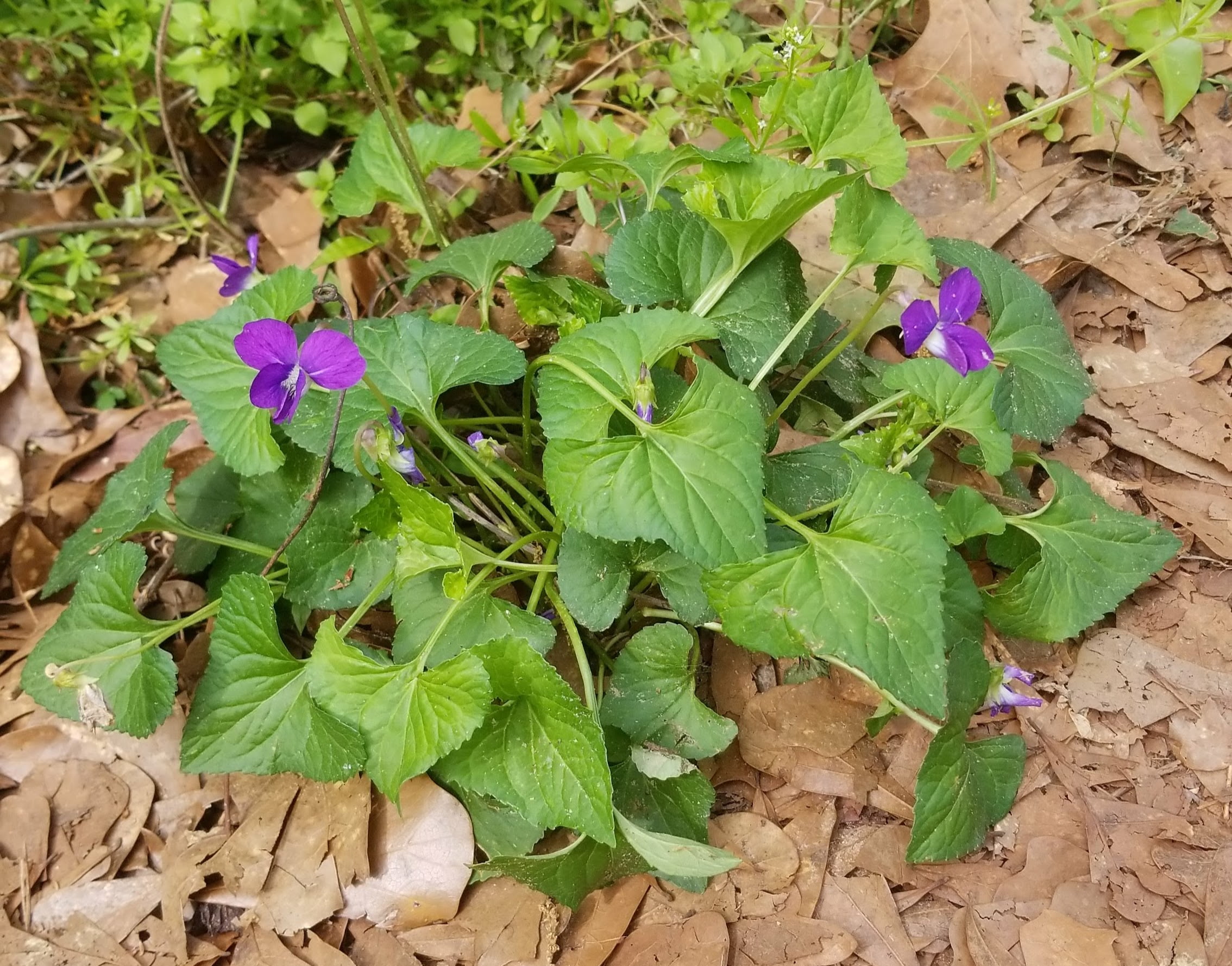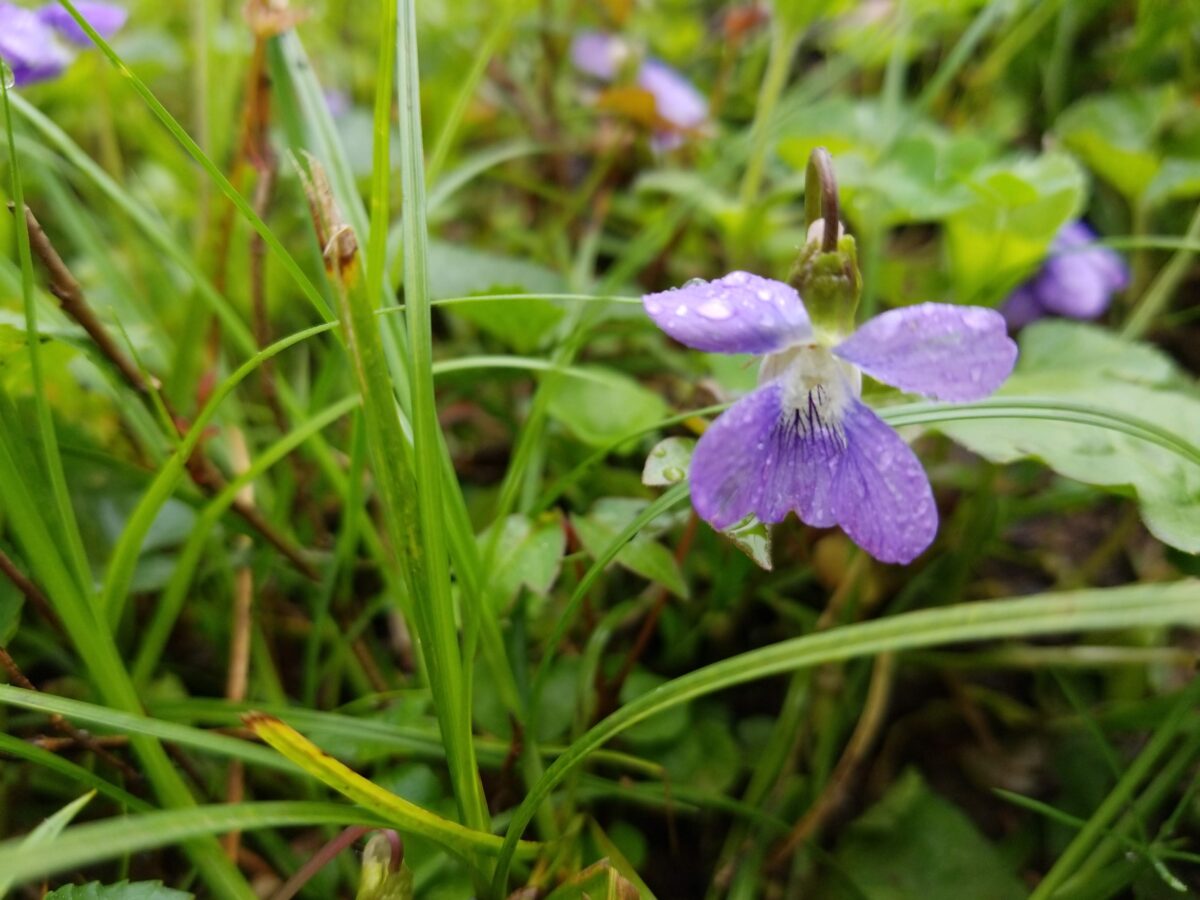Scientific name:
Common blue violet (Viola sororia)Related species:
Sweet Violet (Viola odorata)
Sand violet (Viola affinis)Other common names:
sweet violet, wild violet, dog violet, wood violet, piss-a-bedsOther languages:
Zi Hua Di Ding 紫花地丁 (Chinese, refers specifically to Viola yedoensis)
Zǐ Huā Dì Dīng (Pinyin, refers specifically to Viola yedoensis)
Hojebigot (Korean, refers specifically to Viola yedoensis)
Violeta común, viola, violeta de prado común, violeta púrpura, violeta azul lanudo, violeta con capucha y violeta de madera (Spanish, refers most commonly to Viola odorata)
Violeta pentecostés, padre violeta, violeta del norte o violeta papilionácea (Spanish, refers most commonly to Viola sororia)
The name “violet” refers to the smaller, mostly wild flowering species of the plant genus Viola. Violets of one variety or another are widespread across most temperate regions of the globe. There are many varieties of wild violets to be found in North Florida. Either Viola sororia or Viola affinis is the most common species in North Florida depending on who you ask. Some argue the two may be the same species.1 Regardless, knowing the exact species is generally unnecessary since they all have similar medicinal properties and are edible.
They have been used medicinally for thousands of years and are documented in ancient Rome, Iranian traditional medicine, Chinese traditional medicine, and the medicinal practices of indigenous peoples in North America. Sweet violets (Viola odorata) are a European variety most known for their scent and traditionally used in perfume. Violets native to North America are less strongly scented but share the same medicinal properties. Species of violet with little or no scent are sometimes called dog violets. Violets get their scent from ionone which is why the scent seems to come and go. After a few moments, ionone binds to our scent receptors and temporarily shuts them off. Once that wears off we smell them again as if for the first time.2
The name “violet” is derived from the Latin word “viola” which is the Latin name for the color we call violet in English. So violets are named after their color, even though violets come in a variety of colors from white to yellow to blue and violet.3 Before Latin, viola came from the Greek word Vion, a variation of the name Io, a priestess to the goddess Hera. Zeus seduced Io and Hera punished her for it by transforming the priestess into a white cow. Zeus, as an apology or maybe to make up for her now being a cow, transformed her falling tears into violets for her to eat.4
Identification


Violets are a low-growing perennial with heart-shaped leaves and blue-violet (sometimes white or yellow) flowers. The flowers have 5 petals with a furry whitish center and a bottom drooping petal. They are symmetrical from side to side but not from top to bottom. Each flower appears on the end of its own leafless stalk. The leaves are heart or kidney-shaped and have toothed edges.
African violets (Saintpaulia) are a popular houseplant native to East Africa. They are completely different from native “true” violets and are not edible.
Growing/Foraging
Violets like shade, especially in hotter regions like Northern Florida. They grow in woods, thickets, and shaded parts of yards. They like moist rich soil and can often be found near streams or anywhere well irrigated. They bloom in the early Spring and late Fall and are generally easy to find during those seasons.
Violet flowers are of a shape ideal for pollination by bees, but they bloom too early in the season for most bees and don’t produce seeds unless there are specialized pollinators in the region. Instead, violets reproduce mainly through underground rhizomes.5 Flowers that are pollinated droop down to the ground and stay there until the Fall when the brown seed heads split open and shoot their seeds out.6 As always, only take your share and leave plenty of flowers for the pollinators.
Violets can be easily transplanted or started from rhizomes and will thrive if cared for and kept clear of weed pressure.
Sustainability
Violets are the host plant for a range of butterflies known as fritillaries. Like monarch butterflies and milkweed, fritillaries butterfly larva only feed on violets. There is also a species of mining bee that only pollinates violets.7
Medicinal and Food Properties
The flowers and leaves of the violet are expectorants – they expel mucus and break up congestion. They are also demulcent and antiseptic, meaning they soothe irritation and help prevent infection by inhibiting the growth of infectious agents. These actions together make violets ideal for relieving upper respiratory and chest congestion, sore throat, and asthma.8 For children, a syrup made from flowers is a gentle and sweet-tasting way to relieve a cough or sore throat, or as a mild laxative.9
American Herbalist James Duke says violets would be an effective remedy for varicose and spider veins. The flowers contain rutin, a compound that promotes the strength of capillary walls He estimates you would need a few tablespoons a day to significantly strengthen the capillaries.10 In addition, research has shown that violet flowers can help reduce blood pressure and improve cardiovascular health.11 12
Violet has a long history as an anti-cancer herb. Not only does it reduce pain it has also been shown to inhibit the growth of tumors and reduce the spread of cancer to other parts of the body.13 14
The leaves are antiseptic, meaning they fight infection and therefore can be used as a poultice for itching, acne, skin rashes, eczema, and other skin problems.15 16
In traditional Chinese Medicine, violet (specifically Viola yedoensis) is understood to work through the heart and liver. It’s a cooling, bitter, and pungent herb. It’s the primary ingredient of Wu Wei Xiao Du Yin, a blend of five herbs used to cool the blood, reduce swelling, and resolve toxins in the body.17 By itself, the herb is also used to treat boils, abscesses, and snake bites.18 Chinese researchers have validated much of this traditional use by exploring the herb’s anti-inflammatory qualities19 and the herb’s direct effect on the liver and kidneys.20
Violet’s cooling nature has a calming effect that helps with general tension, headache, and sleeplessness, in addition to high blood pressure as stated above. As a tea, it’s effective at easing tension headaches.21 A study done in 2018 found that an Iranian traditional medicine, a combination of sweet violet flowers, Damask rose flowers, and coriander pods in a capsule notably reduced the frequency and severity of migraines.22 Studies have shown that violet oil nasal drops, nightly, help relieve chronic insomnia.23 24
Violet leaves are high in vitamin C. They also contain vitamin A, various minerals, and saponins.25 Katja Swift from Commonwealth Holistic Herbalism recommends violets as a great alternative to nettles for people who run dry.26
Safety
Avoid very high doses of the plant; it contains saponins that can cause nausea and vomiting. The roots are strongly emetic, meaning they will make you throw up – a lot.27 Cases have been reported in which nervous and circulatory disorders and even death have occurred due to an overdose of the content of the roots.28
There isn’t enough information to know if violet is safe to use when pregnant or breastfeeding. Violet is possibly safe in children 2-12 years old when taken by mouth in recommended doses or applied topically to the skin. While violet syrup is a traditional medicine given to children, there is no scientific research to know if this is absolutely safe.29
Avoid internal use with those who have the disorder G6PD (glucose-6-phosphate dehydrogenase) deficiency. It can aggravate hemolytic anemia.30
African violets (Saintpaulia) are a popular houseplant native to East Africa. They are completely different from native “true” violets and are not edible.
Preparation
Violet flowers and leaves can be eaten raw or cooked, made into a poultice for external use, or made into tea.
Violet leaves can be dried. The flowers lose much of their potency when dried and are best preserved by crystallizing them with sugar first.
Violet syrup, made with flowers and honey or sugar, is an ideal way to get the herb into the mouth and throat to relieve cough, sore throat, or inflamed gums.31 Violet syrup can also be used to sweeten tea and other beverages.
Violets lend their color and scent to liquids and can be infused in wine, tea, syrup, vinegar, and honey to give them a floral aroma and striking purple color.32 The pigment in the violet-colored flowers is pH reactive. When mixed with an alkaline liquid it will turn blue and when mixed with an acid, it will turn pink or even red.33
If you want to extract the minerals and vitamins from violet leaves, it’s best to eat them fresh or dried; or do a long cold infusion in water or apple cider vinegar.
For topical use, fresh violets can be crushed for a poultice. Dried or partially dried (for 24-48 hours) leaves and flowers can be infused in oil to make slaves and creams.
Recipes
-
Té Corazón Lastimado (Wounded Heart Tea)
Poniendo a Tierra el Dolor Con la Verdad La semana pasada recibimos la noticia devastadora de que une queride miembre de nuestra comunidad fue disparade por la policía en el condado de DeKalb de Atlanta, Georgia, mientras defendía el bosque Weelaunee de destrucción. Se devastarán ochenta y cinco (85) hectáreas de tierra ocupada por colonos,…
-
Violet Syrup and Alternatives
Violet syrup is a gentle and tasty way to prepare the herb for medicinal and culinary use. For children, a syrup made from violet flowers is a gentle and sweet-tasting way to relieve a cough or sore throat, or as a mild laxative. The syrup can also be used to sweeten and flavor tea, coffee,…
Sources

